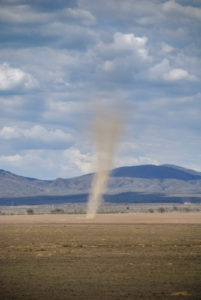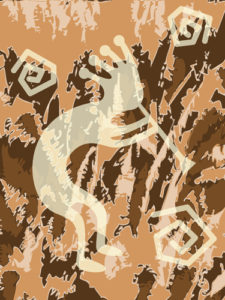DUST DEVILS, WHIRLWINDS, WILLY-WILLIES
(But not “willywaws” – those are something else.)

The world-wide plains of our continents are full of them, those mysterious rising ropes of writhing dirt. Even the oceans have them, where they’re called water spouts. Skinniest of tornadoes, if you will, a rotating tight spin of air sucking up loose things that make them visible. Thermals, those rising columns of heat that top off with a cloud formation at condensation levels, can take that whirling dust up thousands of feet.
Once, flying north out of Mexico on approach to Phoenix at 5,000 feet, we spotted one a mile or so off our wing, then a few others here and there in the hazy distance.
I called the controller and expressed my surprise and awe. I could visualize his blasé shrug as he said, “First time out here, or what? We get those all the time.”
The ones I remembered from childhood dotted the desert, reflected in mirages, bringing to mind cowboys and cattle and the song “Cool, Clear, Water. ” This was way different. I meekly responded with a “Roger.”
Once we saw one on a taxiway at the Tucson airport, an oddity that appeared ahead of us, as thin as a pencil, moving along the route to our tie down. Was it dangerous? We stopped, mesmerized, and announced our dismay to Ground Control, then watched as it wandered off and dissipated.
“Yeah, we get those sometimes. They’ll spoil your paint job,” replied Ground.
From our hillside Tucson home in the Catalinas, selected for its fine view of Old Pueblo (Tucson’s original name) and the wide Sun Corridor around and beyond it, now and then we spy a rise of dust, a fat puff forming into a vertical thread, coming off perhaps a downtown construction site. As the air mass moves it, a wind shift probably, the dust column is directed away from its source. It breaks up and falls away. Usually.
Sometimes they turn into those “Devil not a man” things, showing us that the far west spirits are still there. Populate the plains as much as you will, you can’t cover it up. The Tohono O’odham Indians, a large group whose territory abutted the peaceful Hopi, were here first; their culture influences life today. You find traces in names and beliefs. Their dancing fertility god Kokopelli, the flute player, celebrated on tourist paraphernalia, is one. It was believed the hunchback tootled babies into being – and rain. Many of these agricultural peoples farmed in flash flood waters and mountain runoffs. Those thermals can rise up to bring us storms – when there’s enough moisture in the clouds.

If you look with eyes clear, then squint, sometimes you can see Kokopelli dancing with his flute through the climbing haze. They say the Tohono O’odham see him.
Maybe so do I.
We had lots of them in Texas on our farm. Love you, Michelee. Come see us in MA sometime again.
Yes, Texas has them too 😊
Going to ACONE Lovell event – quick trip.
In and out chop-chop. You going?
“mysterious rising ropes of writhing dirt”
I love phrases like that…
Thanks – it’s fun thinking them up.
Lovely atmospheric piece! Thanks for posting! 😉
Here in Austria, we lately had more than enough of a kind of “wet dust devils” – midi-tornadoes and heavy rains that tear up trees and peel off tin roofs. Very unusual. Seems that global warming is not a fabrication of the Chinese or the Paris Climate Accord people …
Hugs, Walter